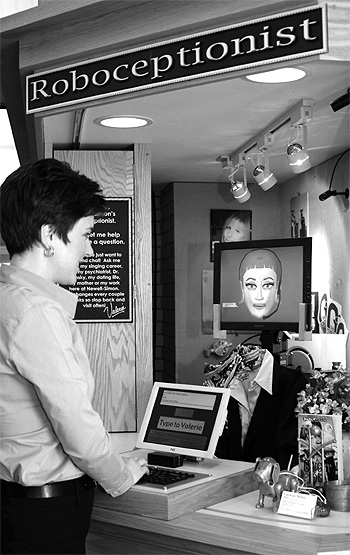Valerie, a "woman" with lots of attitude and many stories to tell, sits in a special reception booth in the Newell-Simon lobby, turning her brilliant blue gaze on everyone who passes by. Her sensors alert her to people and she offers assistance and directions to lost, confused or questioning visitors.
She's one of the world's first storytelling roboceptionists and she's only at Carnegie Mellon.

Valerie spends a lot of time talking on the telephone—just like a human receptionist. People can overhear her conversations with friends, business callers and with her parental advisor, her "motherboard." If you ask the right questions, she'll tell you about her life, her psychiatrist, her aspirations to be a lounge singer and how much she hates to date vacuum cleaners.
Valerie is the product of a two-and-a-half-year collaboration between researchers and students in Carnegie Mellon's Robotics Institute in the School of Computer Science and the School of Drama in the College of Fine Arts.
Reid G. Simmons, research professor in the Robotics Institute, and Anne Mundell, associate professor in the School of Drama, have brought together an unusual mix of art and technology to create Valerie. Mundell has a special interest in computer applications for the theater. And Simmons, an expert in artificial intelligence and social robots, has been working for several years on human-robot social interaction.
Mundell says the collaboration has allowed the partners to look at their disciplines in new and enlightened ways and discover some surprising commonalities. She sees work in drama and robotics as the same kind of creative process, "just developed in different languages."
"For the most part, the technology bringing Valerie to life involves building on what we've used in the past, but deploying it in a totally new way," said Simmons. "It's theater, storytelling in a way that's never been done."
Valerie has a highly expressive female face displayed on a computer monitor attached to a pan-tilt head on a commercial mobile robot from iRobot. A SICK laser scanner (manufactured by the Swedish firm, SICK AG) detects and tracks people as they move around her booth. People communicate with her via keyboard and she responds using computer-generated speech.
Mundell's expertise in and emotion combined with her students' skills in writing dialogue add depth to Valerie's character, which is programmed into her with software developed by Simmons and his students. Mundell and her students modeled Valerie's facial expressions while Simmons and his students' software put a moving muscular structure underneath them. The fine arts students' expressions and dialogue are incorporated into Valerie using robotics software.
Valerie's Web site, www.roboceptionist.com, details everything about her life, including the family photo album and videos of her in action.
"It's a wonderful collaboration," said Simmons. "Right now, we're building up things Valerie can talk about and giving her the ability to remember people."
"We've wanted a robotic presence in the computer science building for nearly 10 years," said Simmons, "especially since we're now focused on human-robot social interaction. At the same time, we wanted to make Valerie interesting to the inhabitants of the building. To keep her interesting, we thought she should be a storyteller."



